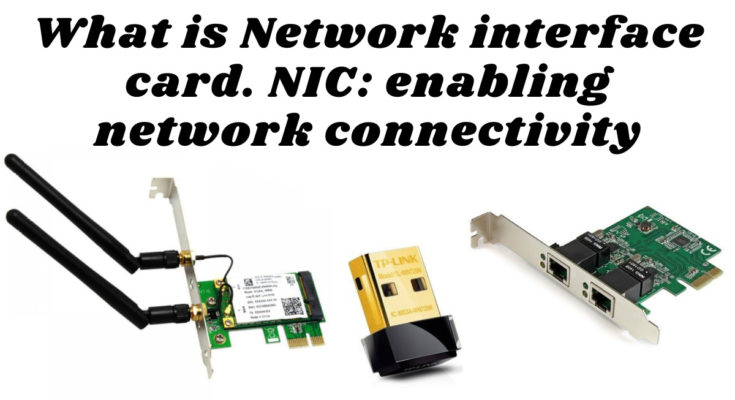NETWORK INTERFACE CARD :-
A network interface card (NIC), also known as a network adapter or LAN adapter, is a hardware component that enables a computer or other device to connect to a network. The NIC is responsible for converting digital data from the computer into a form that can be transmitted over the network, as well as receiving and processing data that is sent to the computer from the network.
NICs come in a variety of forms, including internal cards that are installed inside a computer, external devices that connect to a computer’s USB or Thunderbolt port, and wireless adapters that allow a computer to connect to a wireless network. NICs can support a range of network protocols, such as Ethernet, Wi-Fi, and Bluetooth, and can operate at different data transfer rates, such as 10 Mbps, 100 Mbps, 1 Gbps, or higher.
NICs are essential for any computer or device that needs to communicate with other devices on a network, whether it’s a local area network (LAN) within a home or office, or a wide area network (WAN) such as the Internet.
NIC: ENABLING NETWORK CONNECTIVITY
A NIC is responsible for enabling network connectivity for a computer or other device. When a computer or device is equipped with a NIC, it can connect to a network and communicate with other devices on that network, as well as access resources that are shared on the network.
Without a NIC, a computer or device would not be able to connect to a network and would be limited to standalone use. For example, a computer without a NIC would not be able to access the Internet, connect to a printer that is shared on a network, or participate in online gaming or video conferencing with other users.
NICs can connect to a network using a variety of protocols, such as Ethernet, Wi-Fi, or Bluetooth, depending on the type of network and the available hardware. The NIC is responsible for converting digital data from the computer into a form that can be transmitted over the network, as well as receiving and processing data that is sent to the computer from the network.
TYPES :-
There are several types of NICs available, including:
1. Internal NICs: These are network adapters that are installed inside a computer and connect directly to the motherboard. They are often referred to as expansion cards and can be PCI, PCIe, or ISA based.
2. External NICs: These are network adapters that connect to a computer through a USB or Thunderbolt port. They are typically used for laptops or other devices that do not have an internal expansion slot available.
3. Wireless NICs: These are network adapters that use Wi-Fi or Bluetooth to connect a computer or other device to a wireless network.
4. Fiber NICs: These are network adapters that use fiber optic cables to connect a computer or other device to a network. They are typically used in high-speed networks and can support data transfer rates of up to 100 Gbps.
5. Ethernet NICs: These are network adapters that use Ethernet cables to connect a computer or other device to a network. They are the most common type of NIC and are available in a variety of speeds, including 10 Mbps, 100 Mbps, 1 Gbps, 10 Gbps, and higher.
NICs can also be categorized based on the number of ports they have. For example, a single-port NIC has one network connection, while a dual-port NIC has two connections and can support multiple networks or provide redundancy in case of a network failure.
FUNCTIONS :-
The primary function of a network interface card (NIC) is to enable a computer or other device to connect to a network and communicate with other devices on that network. Here are some of the key functions that a NIC performs:
1. Data conversion: The NIC converts digital data from the computer into a form that can be transmitted over the network, and also converts incoming data into a form that the computer can understand.
2. Network protocol support: The NIC supports one or more network protocols, such as Ethernet, Wi-Fi, or Bluetooth, which determine how data is transmitted and received over the network.
3. Data transmission: The NIC sends data packets from the computer to the network and receives data packets from the network and delivers them to the computer.
4. Network addressing: The NIC provides the computer with a unique network address, such as an IP address or MAC address, which is used to identify the computer on the network.
5. Error detection and correction: The NIC performs error detection and correction to ensure that data is transmitted and received correctly.
6. Network speed control: The NIC controls the speed at which data is transmitted and received over the network, based on the network speed and the capabilities of the computer and NIC.
7. Network security: The NIC can support network security protocols, such as encryption or authentication, to protect data as it is transmitted over the network.
Overall, the NIC plays a crucial role in enabling network connectivity and communication for computers and other devices.



